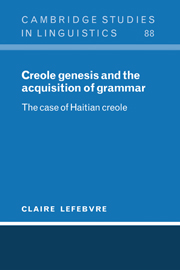Book contents
- Frontmatter
- Contents
- Tables
- Preface
- Abbreviations
- 1 The problem of creole genesis and linguistic theory
- 2 Cognitive processes involved in creole genesis
- 3 The research methodology
- 4 Functional category lexical entries involved in nominal structure
- 5 The preverbal markers encoding relative Tense, Mood and Aspect
- 6 Pronouns
- 7 Functional category lexical entries involved in the structure of the clause
- 8 The determiner and the structure of the clause
- 9 The syntactic properties of verbs
- 10 Are derivational affixes relexified?
- 11 The concatenation of words into compounds
- 12 Parameters
- 13 Evaluation of the hypothesis
- 14 Theoretical consequences
- Appendices
- Notes
- References
- Index of authors
- Index of languages and language families
- Index of subjects
8 - The determiner and the structure of the clause
Published online by Cambridge University Press: 23 November 2009
- Frontmatter
- Contents
- Tables
- Preface
- Abbreviations
- 1 The problem of creole genesis and linguistic theory
- 2 Cognitive processes involved in creole genesis
- 3 The research methodology
- 4 Functional category lexical entries involved in nominal structure
- 5 The preverbal markers encoding relative Tense, Mood and Aspect
- 6 Pronouns
- 7 Functional category lexical entries involved in the structure of the clause
- 8 The determiner and the structure of the clause
- 9 The syntactic properties of verbs
- 10 Are derivational affixes relexified?
- 11 The concatenation of words into compounds
- 12 Parameters
- 13 Evaluation of the hypothesis
- 14 Theoretical consequences
- Appendices
- Notes
- References
- Index of authors
- Index of languages and language families
- Index of subjects
Summary
The definite determiner found in the nominal structure of Haitian and Fongbe (see chapter 4) also plays a central role in the structure of the Haitian and Fongbe clause (see Lefebvre 1982b, 1991c, 1992b, 1996a, to appear b). In fact, the semantics of the determiner and the various functions that it may perform provide information concerning the structure of the clause in these two languages. This finds no parallel in French, for, in this language, the determiner plays no role at all in clause structure. This chapter discusses the distribution of the determiner as it occurs in simple Haitian and Fongbe clauses. It is argued that the determiner occurring in the clause may appear as the head of several functional category projections, namely, MoodP1, MoodP2, tp and AspP. The data presented in this chapter are drawn from a sample of speakers of both languages (see Lefebvre 1992b, to appear b). Two clear patterns emerge which will be referred to as grammar 1 (which includes speakers of both Haitian and Fongbe) and grammar 2 (which also includes speakers of both Haitian and Fongbe). The striking fact about these data is that the same cluster of properties distinguish grammar 1 from grammar 2 in both languages.
The functions of the determiner in clause structure
As shown in (1), when the determiner occurs in the context of a clause, it may be assigned three slightly different interpretations. Throughout this chapter, the clausal determiner will be glossed as Det rather than as det since it is argued not to project to dp.
Information
- Type
- Chapter
- Information
- Creole Genesis and the Acquisition of GrammarThe Case of Haitian Creole, pp. 219 - 247Publisher: Cambridge University PressPrint publication year: 1999
